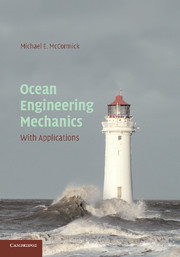Book contents
- Frontmatter
- Contents
- Preface
- Notation
- OCEAN ENGINEERING MECHANICS
- 1 Introduction
- 2 Review of Hydromechanics
- 3 Linear Surface Waves
- 4 Nonlinear Surface Waves
- 5 Random Seas
- 6 Wave Modification and Transformation
- 7 Waves in the Coastal Zone
- 8 Coastal Engineering Considerations
- 9 Wave-Induced Forces and Moments on Fixed Bodies
- 10 Introduction to Wave-Structure Interaction
- 11 Wave-Induced Motions of Floating Bodies
- 12 Wave-Induced Motions of Compliant Structures
- Appendices
- References
- Index
2 - Review of Hydromechanics
Published online by Cambridge University Press: 05 June 2012
- Frontmatter
- Contents
- Preface
- Notation
- OCEAN ENGINEERING MECHANICS
- 1 Introduction
- 2 Review of Hydromechanics
- 3 Linear Surface Waves
- 4 Nonlinear Surface Waves
- 5 Random Seas
- 6 Wave Modification and Transformation
- 7 Waves in the Coastal Zone
- 8 Coastal Engineering Considerations
- 9 Wave-Induced Forces and Moments on Fixed Bodies
- 10 Introduction to Wave-Structure Interaction
- 11 Wave-Induced Motions of Floating Bodies
- 12 Wave-Induced Motions of Compliant Structures
- Appendices
- References
- Index
Summary
The term hydromechanics normally refers to that part of fluid mechanics devoted to both the hydrostatics and hydrodynamics of incompressible flows. The term includes the effects of free surface at the air-sea interface. Although the focus of the discussion of hydrodynamic topics is on incompressible flows in this chapter, a discussion of hydrostatics includes the effects of the compressibility of seawater at great water depths. Because this is a review chapter, all aspects of hydrodynamics are not addressed. The reader is referred to the book by Robert A. Granger (1985) for an expanded coverage of the topics.
We begin our review of hydromechanics with a discussion of hydrostatics. Although this subject is basic to a course in fluid mechanics, hydrostatics is often neglected in favor of topics that are of more interest to the instructor. However, for the designer of deep-submergence vehicles, a thorough knowledge of the fundamentals of hydrostatics is required.
Hydrostatics
A discussion of hydrostatics must begin by paraphrasing Archimedes' Principle: A body placed in a liquid loses an amount of weight equal to the weight of the liquid that it displaces. From this simple observation, the hydrostatic equation can be derived. Consider the can buoy sketched in Figure 2.1, which displaces a volume (∨) of water. In that sketch, W is the buoy weight, A is the cross-sectional area, and d is the buoy draft.
- Type
- Chapter
- Information
- Ocean Engineering MechanicsWith Applications, pp. 7 - 43Publisher: Cambridge University PressPrint publication year: 2009



